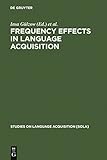Frequency Effects in Language Acquisition : Defining the Limits of Frequency as an Explanatory Concept / ed. by Natalia Gagarina, Insa Gülzow.
Material type: TextSeries: Studies on Language Acquisition [SOLA] ; 32Publisher: Berlin ; Boston : De Gruyter Mouton, [2011]Copyright date: ©2007Description: 1 online resource (416 p.)Content type:
TextSeries: Studies on Language Acquisition [SOLA] ; 32Publisher: Berlin ; Boston : De Gruyter Mouton, [2011]Copyright date: ©2007Description: 1 online resource (416 p.)Content type: - 9783110196719
- 9783110977905
- 401/.93 22
- P118 .F755 2007eb
- online - DeGruyter
- Issued also in print.
| Item type | Current library | Call number | URL | Status | Notes | Barcode | |
|---|---|---|---|---|---|---|---|
 eBook
eBook
|
Biblioteca "Angelicum" Pont. Univ. S.Tommaso d'Aquino Nuvola online | online - DeGruyter (Browse shelf(Opens below)) | Online access | Not for loan (Accesso limitato) | Accesso per gli utenti autorizzati / Access for authorized users | (dgr)9783110977905 |
I-VI -- Introducing the frequency debate in studies of language acquisition -- Opening statement -- What frequency can do and what it can't -- The acquisition of determiners -- The role of input frequency in article acquisition in early child Swedish -- Testing the effects of frequency on the rate of learning: Determiner use in early French, German and Italian -- Input frequencies across development -- The acquisition of non-agent subjects in child Hebrew: The role of input -- The role of input frequency in early language production: Children’s usage of Serbian prepositions -- Characteristics of maternal input in relation to vocabulary development in children learning German -- What happens when adults often use infinitives? -- Frequency mismatches between caregiver input and child language -- Structural versus frequency effects in L1 acquisition of the passive and impersonal in Serbian -- The (non-) effect of input frequency on the acquisition of word order in Norwegian embedded clauses -- Factors determining the acquisition of animacy in Czech -- (Non-)Frequentist perspectives within UG -- A note on acquisition in frequency-based accounts of binding phenomena -- Principles, parameters and probabilities -- Comments -- The role of frequency in language acquisition -- Counting grammars -- List of contributors -- Index
restricted access online access with authorization star
http://purl.org/coar/access_right/c_16ec
The book addresses a controversial current topic in language acquisition studies: the impact of frequency on linguistic structure in child language. A major strength of the book is that the role of input frequency in the acquisition process is evaluated in a large variety of languages, topics and the two major theoretical frameworks: UG-based and usage-based accounts. While most papers report a clear frequency effect, different factors that may be interacting with pure statistical effects are critically assessed. An introductory statement is made by Thomas Roeper who calls for caution as he identifies frequency as a non-coherent concept and argues for a precise definition of what can and cannot be explained by statistical effects.
Issued also in print.
Mode of access: Internet via World Wide Web.
In English.
Description based on online resource; title from PDF title page (publisher's Web site, viewed 28. Feb 2023)


